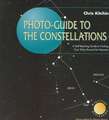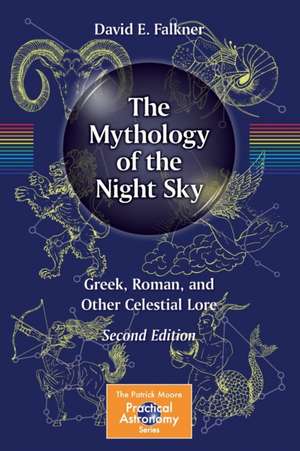The Mythology of the Night Sky: Greek, Roman, and Other Celestial Lore: The Patrick Moore Practical Astronomy Series
Autor David E. Falkneren Limba Engleză Paperback – 29 sep 2020
The revised second edition includes a host of new moons and dwarf planets discovered since 2011. In addition, it now features a new section on major asteroids and their associated myths. While still primarily focused on Greco-Roman mythology, the book now branches out to cover more recently named objects from other cultures, such as Hawaiian, Rapanui, Tongva and Inuit.
To assist practical observers, the book gives the location and description of each constellation, including named stars and deep-sky objects. A host of helpful astronomy tips and techniques, as well as a brief introduction to astrophotography, are included to encourage direct observation and imaging of these mythical objects in the night sky.
Din seria The Patrick Moore Practical Astronomy Series
-
 Preț: 258.21 lei
Preț: 258.21 lei -
 Preț: 164.94 lei
Preț: 164.94 lei -
 Preț: 298.91 lei
Preț: 298.91 lei -
 Preț: 255.10 lei
Preț: 255.10 lei - 8%
 Preț: 581.98 lei
Preț: 581.98 lei -
 Preț: 159.16 lei
Preț: 159.16 lei -
 Preț: 282.38 lei
Preț: 282.38 lei -
 Preț: 308.55 lei
Preț: 308.55 lei -
 Preț: 309.87 lei
Preț: 309.87 lei -
 Preț: 332.98 lei
Preț: 332.98 lei -
 Preț: 251.60 lei
Preț: 251.60 lei -
 Preț: 243.94 lei
Preț: 243.94 lei -
 Preț: 183.40 lei
Preț: 183.40 lei -
 Preț: 378.09 lei
Preț: 378.09 lei -
 Preț: 302.20 lei
Preț: 302.20 lei -
 Preț: 210.01 lei
Preț: 210.01 lei -
 Preț: 212.68 lei
Preț: 212.68 lei -
 Preț: 271.39 lei
Preț: 271.39 lei -
 Preț: 252.91 lei
Preț: 252.91 lei -
 Preț: 256.64 lei
Preț: 256.64 lei -
 Preț: 264.56 lei
Preț: 264.56 lei -
 Preț: 218.84 lei
Preț: 218.84 lei -
 Preț: 257.08 lei
Preț: 257.08 lei -
 Preț: 128.86 lei
Preț: 128.86 lei -
 Preț: 301.10 lei
Preț: 301.10 lei -
 Preț: 204.78 lei
Preț: 204.78 lei -
 Preț: 307.44 lei
Preț: 307.44 lei -
 Preț: 303.07 lei
Preț: 303.07 lei -
 Preț: 258.83 lei
Preț: 258.83 lei -
 Preț: 155.25 lei
Preț: 155.25 lei -
 Preț: 193.97 lei
Preț: 193.97 lei -
 Preț: 208.26 lei
Preț: 208.26 lei -
 Preț: 279.09 lei
Preț: 279.09 lei -
 Preț: 303.51 lei
Preț: 303.51 lei -
 Preț: 252.24 lei
Preț: 252.24 lei -
 Preț: 208.51 lei
Preț: 208.51 lei -
 Preț: 214.86 lei
Preț: 214.86 lei -
 Preț: 304.58 lei
Preț: 304.58 lei -
 Preț: 220.57 lei
Preț: 220.57 lei -
 Preț: 157.32 lei
Preț: 157.32 lei -
 Preț: 250.68 lei
Preț: 250.68 lei -
 Preț: 288.98 lei
Preț: 288.98 lei -
 Preț: 261.49 lei
Preț: 261.49 lei -
 Preț: 279.09 lei
Preț: 279.09 lei -
 Preț: 160.82 lei
Preț: 160.82 lei -
 Preț: 301.72 lei
Preț: 301.72 lei -
 Preț: 254.90 lei
Preț: 254.90 lei -
 Preț: 304.38 lei
Preț: 304.38 lei -
 Preț: 256.84 lei
Preț: 256.84 lei
Preț: 195.53 lei
Nou
Puncte Express: 293
Preț estimativ în valută:
37.42€ • 38.66$ • 31.14£
37.42€ • 38.66$ • 31.14£
Carte disponibilă
Livrare economică 04-18 martie
Livrare express 15-21 februarie pentru 41.22 lei
Preluare comenzi: 021 569.72.76
Specificații
ISBN-13: 9783030476939
ISBN-10: 3030476936
Pagini: 250
Ilustrații: XVI, 331 p. 89 illus., 79 illus. in color.
Dimensiuni: 155 x 235 x 26 mm
Greutate: 0.59 kg
Ediția:Second Edition 2020
Editura: Springer International Publishing
Colecția Springer
Seria The Patrick Moore Practical Astronomy Series
Locul publicării:Cham, Switzerland
ISBN-10: 3030476936
Pagini: 250
Ilustrații: XVI, 331 p. 89 illus., 79 illus. in color.
Dimensiuni: 155 x 235 x 26 mm
Greutate: 0.59 kg
Ediția:Second Edition 2020
Editura: Springer International Publishing
Colecția Springer
Seria The Patrick Moore Practical Astronomy Series
Locul publicării:Cham, Switzerland
Cuprins
Recenzii
“This book is a worthy addition to the literature on the names of heavenly bodies, and can be recommended.” (Robert Connon Smith, The Observatory, Vol. 141 (1282), June, 2021)
Notă biografică
David Falkner first became interested in Astronomy as a pre-teen when his father took him to a show at the Holcolm Planetarium in Indianapolis, IN. He became hooked and has loved astronomy ever since. When he was a teenager he inherited a home-made Newtonian telescope that needed the primary mirror. He ground a 6” mirror and completed his first telescope, which gave him years of pleasure observing the heavens. In 1973 David joined the US Navy and became an officer in 1980. In 1986 as a Naval Officer stationed in Monterey, California he was involved with the Friends of MIRA (Monterey Institute for Research in Astronomy) where he conducted outreach to local schools associated with the return of Halley’s Comet. David retired from the US Navy in 1993 and settled in Minnesota where he continues his love of astronomy. He has taught introductory Astronomy at a local community college and does extensive astronomy outreach both a NASA Solar System Ambassador and as President of the Minnesota Astronomical Society.
Textul de pe ultima copertă
This book is for amateur astronomers who would like to know the mythology behind the names of astronomical objects in the night sky. It covers the lore and legend behind Ptolemy’s 48 constellations, along with significant asterisms, the planets and their moons, the brightest named asteroids and dwarf planets.
The revised second edition includes a host of new moons and dwarf planets discovered since 2011. In addition, it now features a new section on major asteroids and their associated myths. While still primarily focused on Greco-Roman mythology, the book now branches out to cover more recently named objects from other cultures, such as Hawaiian, Rapanui, Tongva and Inuit.
To assist practical observers, the book gives the location and description of each constellation, including named stars and deep-sky objects. A host of helpful astronomy tips and techniques, as well as a brief introduction to astrophotography, is included to encourage direct observation and imaging of these mythical objects in the night sky.
The revised second edition includes a host of new moons and dwarf planets discovered since 2011. In addition, it now features a new section on major asteroids and their associated myths. While still primarily focused on Greco-Roman mythology, the book now branches out to cover more recently named objects from other cultures, such as Hawaiian, Rapanui, Tongva and Inuit.
To assist practical observers, the book gives the location and description of each constellation, including named stars and deep-sky objects. A host of helpful astronomy tips and techniques, as well as a brief introduction to astrophotography, is included to encourage direct observation and imaging of these mythical objects in the night sky.
Caracteristici
Balances “backyard astronomer” observation with mythology Organized by season for convenient practical observations Serves as a great resource for astronomy lectures and star parties
